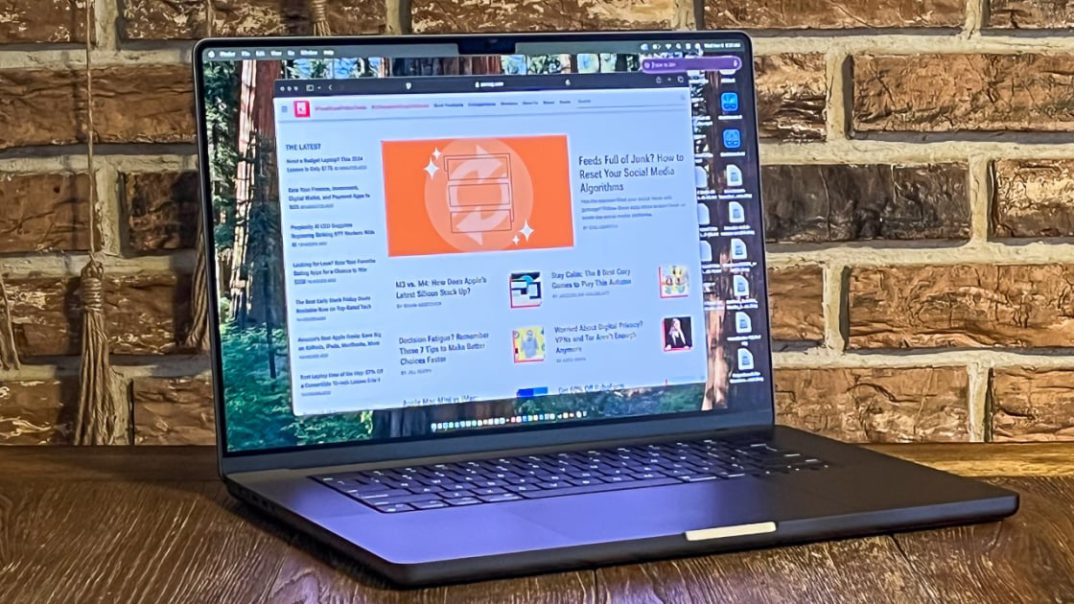Apple has once again stolen a march against leading mobile workstation laptops with the 16-inch MacBook Pro (starts at $2,499; $3,649 as tested). The M4 Pro-equipped version reviewed here proves competitive with some of the best silicon from AMD, Intel, and Nvidia—particularly in content-creation tasks. On top of the blazing speeds, Apple now offers the must-have nano-texture display feature that reduces screen glare and reflections (though it’s an optional, added-cost extra). The company also now adds its Center Stage webcam tech to the MacBook Pro, which is helpful if not quite as exciting as the nano-texture screen. Delivering all-day battery life once again on top of it all, the 16-inch MacBook Pro with M4 Pro earns an Editors’ Choice award for high-end mobile workstations.
Configurations: Apple’s Most Money-Hungry MacBook
Bumping up the MacBook Pro’s screen size to 16.2 inches mandates a steep price hike over the entry-level 14-inch version. (The 14-incher starts at $1,599.) At least the 16-incher bundles in the M4 Pro processor as its CPU baseline. In its ground-floor model, the 16-inch MacBook Pro comes with the M4 Pro, 24GB of unified memory, and a 512GB solid-state drive with everything else that all 16-inch MacBook Pro models get, like Thunderbolt 5 connectivity, for $2,499.
Since 1982, PCMag has tested and rated thousands of products to help you make better buying decisions. See how we test.
All MacBook Pro models come in either Apple’s silver or Space Black colors, and configuration upgrades range from $200 to $900, depending on the part. Processor upgrades are the priciest upticks, while doubling the storage space of the 512GB SSD is “just” $200. The new optional for a nano-texture display (which reduces glare) costs an extra $150.
(Credit: Joe Osborne; Joseph Maldonado)
My specific MacBook Pro configuration—with an M4 Pro, 48GB of memory, a 2TB SSD, and the nano-texture screen—costs a sizable $3,649. However, considering the least-expensive MacBook Pro with the superior M4 Max processor is $3,499 (albeit with less memory and storage), this is not the 16-inch MacBook Pro arrangement I’d go for if I had the cash. (The extra 12 GPU cores are just too juicy to pass up.) Note: You’re stuck with every choice you make at checkout, as you can’t get inside the laptop for later component upgrades.
The most tricked-out 16-inch MacBook Pro rocks an M4 Max with a 16-core CPU and a 40-core GPU, 128GB of memory, an 8TB SSD, and the nano-texture display for a sky-high $7,349.
Design: The Differences Are Down to Nano-Textures
This part of the review is relatively easy to write: Apple changed nothing about its MacBook Pro laptop design except for the optional nano-texture display and the move to Thunderbolt 5 connectivity.
The 2024 16-inch MacBook Pro measures and weighs the same as last year’s model, and none of the connection options has changed or grown in number beyond the Thunderbolt upgrade: three Thunderbolt 5 ports, an HDMI-out, an SD card slot, and an audio jack. I’m still just as appreciative of Apple’s MacBook keyboard and trackpad: They’re consistently among the best you’ll find on any laptop, from the touchpad’s smooth comfort level to the keys’ uniform, bright backlighting.
(Credit: Joe Osborne; Joseph Maldonado)
Likewise, the display remains the same mini LED Liquid Retina XDR panel, displaying 3,456 by 2,234 pixels at up to 120Hz using Apple’s ProMotion variable-refresh-rate technology. The nano-texture option adds material between the glass and the pixel layer to reduce glare and reflections in direct lighting.
And it works. The nano-texture display is an improvement on traditionally glare-prone MacBook displays and a smart upgrade on Apple’s part. You can even see the glare disappear if you look at the screen from about a 170-degree angle and move closer to the front. As someone with sensitive eyes who cranks up Night Shift 24/7, it also helps soften the bite of the display’s several thousand mini LED backlights.
To be clear, it’s one of those display upgrades that will make it tough to use other screens once you get used to it. However, when Apple throws in other upgrades like a new Center Stage webcam with Desk View for no extra cost, I can’t help but balk at the $150 price of an alternative display option. Frankly, this option should be baked into the cost, just like the webcam improvements.
(Credit: Joe Osborne; Joseph Maldonado)
When the nano-texture option was first introduced on the iMac in 2020, it cost $500 extra. It’s currently $1,000 on the Apple Pro Display XDR and $200 on the latest iMac. So, here’s hoping that manufacturing the nano-texture material gets cheap enough for Apple that it can eventually bake it into the price.
As for the aforementioned Center Stage webcam, the automatic centering feature is useful but limited in how far it can follow you across a room. I also question the usefulness of the Desk View addition, which is more useful for iMacs than MacBooks. When used on a short desk, Desk View just shows your torso and below, which isn’t pleasant for the viewer on the other side of the webcam in any daytime scenario. I can imagine ways to make it worthwhile, such as on a larger desk with a raised surface over the keyboard (with another connected to type on), but it’s a niche upgrade.
(Credit: Joe Osborne; Joseph Maldonado)
This has been a winning MacBook design for Apple, so the company has again decided on refinement over reinvention. Of course, if you’re not a fan of Apple’s current MacBook Pro design, then this year’s models do nothing to convince you otherwise.
(Credit: Joe Osborne; Joseph Maldonado)
(Credit: Joe Osborne; Joseph Maldonado)
Using the 16-Inch MacBook Pro: The Most Specialized MacBook
Primarily a desktop replacement or workstation, the 16-inch MacBook Pro is surprisingly dense if you’re otherwise used to tossing around a lithe MacBook Air. Thinness and ultra-portability have never been primary goals for the larger MacBook Pro, instead showcasing how much power Apple can cram into a mobile computer.
With that in mind, the laptop feels like quite a weight on your, well, lap when used on a couch, for instance. If you were to try and push out a large project while using the laptop this way, you’d likely feel some noticeable, if not uncomfortable, heat toward your knees—where the MacBook Pro base meets the screen. The laptop’s cooling fans also become noticeably loud when the chip is firing on all cores, but it’s nothing worse than most other mobile workstations.
(Credit: Joe Osborne; Joseph Maldonado)
The MacBook Pro cools and quiets down quickly after managing heavy loads, but I suggest saving those big renders for when you can get the laptop back to your desk. Besides, all versions of the 2024 MacBook Pro can run in a higher-power energy mode when plugged in, making those tasks take less time.
This year’s macOS update, Sequoia, makes a long-overdue, considerable improvement to the operating system’s window-management tools. I dig more into my thoughts on the many upgrades to macOS via Sequoia in my 2024 Mac mini review, so be sure to read that and our full Sequoia review for more insight. (Just know that window tiling is the best thing to come to Macs since the latest MacBook Pro design revision.)
The same goes for Apple Intelligence, which, in summary, is a fun addition that feels every bit like the open beta test that it is. This open-testing approach marks new ground for Apple as it tries to maintain pace with the competition in this breakneck new field in computing. (Check out our Apple Intelligence first tests to learn more.)
(Credit: Joe Osborne; Joseph Maldonado)
Toiling away on a 16-inch MacBook Pro is a luxury computing experience, but this laptop serves particular use cases. For anything that I would need the power of a MacBook Pro to do, I would much rather get it done in a more comfortable and space-saving desktop Mac arrangement like the new Mac mini with M4 Pro, which is basically identical in capabilities to this MacBook Pro. Then again, I don’t work in the visuals department at a film-production studio and need to jump around an office or to and from home, since I already work from home.
The 16-inch MacBook Pro is a potent and premium laptop, but a somewhat specialized one given the high starting price and its CPU baseline of the M4 Pro. Unless money is no object to you, be honest with yourself about your computing needs before clicking the “buy” button on this one.
Testing the 16-Inch MacBook Pro: If the Mac mini Came With Inputs & a Screen
As you’ll soon see in the benchmark results alone, the M4 Pro behaves in much the same way whether inside a Mac mini desktop or a big-screen MacBook Pro. It’s the same chip, after all. Still, conventional computing logic suggests that the desktop implementation would draw more speed out of it with more powerful cooling and more space for more substantial cooling hardware.
In some tests, the M4 Pro performed slightly faster on the MacBook Pro than the 2024 Mac mini with M4 Pro ($2,199 as tested), but often within the margin of error. It’s an interesting finding, and we may discover that the M4 Pro version of the Mac mini slightly outpaces the M4 Pro in the 14-inch MacBook Pro. However, just don’t expect to get more out of the same chip because it’s in a dense aluminum puck with a big fan inside versus a wide aluminum slab with a keyboard and screen. Read my Mac mini review to see how closely they compare.
At any rate, we also compared the $3,649 16-inch MacBook Pro with last year’s 14-inch MacBook Pro with M3 Pro ($1,999 as tested), last year’s 16-inch MacBook Pro with M3 Max ($7,199 as tested), and this year’s 14-inch MacBook Pro with a 10-core M4 chip ($1,949 as tested). This rounds out the Mac comparisons, leaving room for one of the best recent desktop-replacement laptops, the Asus ProArt P16 ($2,699.99 as tested), and a high-impact workstation like the HP ZBook Fury 16 G11 ($3,564 as tested).
The silicon you see here is some of the best that AMD and Intel have today for similarly sized, performance-focused creator and workstation laptops up against a wave of potent Apple chips.
Productivity & Content Creation Tests
The macOS platform somewhat limits our number of available benchmark tests. (Our seminal PCMark 10 test, in particular, is not supported on Macs.) Still, most of the rest of our tests are comparable across platforms, giving us more competitive insight for Macs than ever.
Our primary performance tests are CPU-intensive: Maxon’s Cinebench 2024 uses that company’s Cinema 4D engine to render a complex scene; Primate Labs’ Geekbench 6.3 Pro simulates popular apps ranging from PDF rendering and speech recognition to machine learning; and we see how long it takes the video editing tool HandBrake 1.8 to convert a 12-minute clip from 4K to 1080p resolution.
Finally, workstation maker Puget Systems’ PugetBench for Creators rates a PC’s image editing prowess with various automated operations in Adobe Photoshop 25, one of Macs’ most popular applications.
In all four tests, the M4 Pro got work done faster than the x86-based AMD or Intel option. While it was impressive to see the M4 Pro edge out the mighty M3 Max, remember that it will be difficult to notice these tiny advantages in performance during regular use—certainly not enough to consider upgrading from the M3 line. Of course, this is said without testing out the M4 Max yet, but Apple’s own published figures paint a picture of small-time generational gains.
After the M4 Pro’s Cinebench win, the story of the M4 Pro’s dominance over some of the best mobile silicon Apple’s competition has to offer carries through the charts. The M4 Pro was a full minute faster at our HandBrake test, and it cleared the x86 competition by several thousand points in the multi-core Geekbench results. Photoshop was yet another several-thousand-point victory for the 16-inch MacBook Pro.
This is especially concerning for the x86 crowd because both systems aren’t far off in price from the MacBook Pro tested here, especially the HP ZBook workstation. The MacBook Pro remains a dominant creation-focused workstation for much the same kind of money as its competition. Just keep the words “creation-focused workstation” in mind, however.
Graphics & Gaming Tests
Because of how the 3DMark suite of tests works on macOS using its iOS app compatibility feature, we could not run our graphics benchmarks on the new Mac computers before publishing our reviews. We will soon update these reviews with graphics test results and comparisons.
In the meantime, I ran the 2022 strategy game Total War: Warhammer 3 on this and a few other recent Macs at Ultra and Low settings at 1080p resolution in the game’s “Battle” benchmark, measuring average frames per second (fps).
Based on these results, we see perhaps one tiny reason to consider upgrading your M3 Pro MacBook Pro to M4 Pro: It can run this game at Ultra settings above 30fps! Jokes aside, without yet testing M4 Max, this is the best it gets for Mac gaming short of a massively powerful Mac Studio desktop.
Apple has been developing the Mac into a viable gaming computer once again for several years now, and its efforts are clearly paying off. While we cannot compare it with Windows gaming machines, these frame rates alone tell the story of a competent mainstream gaming experience. When using the “Recommended” automated settings in the Total War game, both M4 Pro systems held an unwavering 60fps throughout the test.
Workstation Tests
Testing for workstation performance is another area where the Mac misses out on one of our standard tests: SPECviewperf. Other than that, however, the rest of our workstation benchmark suite is also cross-comparable.
First up for Macs is usually the PugetBench extension in the Adobe Premiere Pro video editing app, but we were unable to run this test on M4 Macs, likely due to a software glitch with the testing app rather than any significant deficiency with the computers themselves.
Next is PugetBench for Creators, used to test Blackmagic’s DaVinci Resolve Studio 18 video editor performance using automated tasks to push the CPU and GPU, letting us gauge the upper limits of performance in real-world media creation. Higher numbers are better.
Finally, the Blender Benchmark tests each system in the open-source Blender 3D content creation suite for modeling, animation, simulation, and compositing. The test times each system in Blender 4.2 to render three scenes (Monster, Junk Shop, and Classroom) to measure CPU and GPU rendering performance. Higher numbers are better.
On PugetBench’s DaVinci Resolve Studio benchmark, the M4 Pro put on another (albeit, less dramatic) show for its competition. Again, this solidifies the Mac’s position as a leader in content-creation workstations, if not quite so for 3D modeling.
Apple’s 14-core M4 Pro CPU cluster was able to fend off the ZBook Fury’s 14th Gen Intel mobile workstation chip’s 24 cores. However, the M4 Pro’s 20-core GPU just couldn’t come close to the Nvidia RTX 3500 Ada’s superior core count and 12GB of dedicated video memory. This is where Nvidia’s graphics architecture excels and Apple’s falls behind—we also saw this on the desktop side with the Mac mini. Based on these numbers, both companies have optimized their graphics architectures to serve specific and disparate audiences. While you can undoubtedly get this kind of 3D work done on a Mac, using a Windows system such as the ProArt or ZBook might be faster. The inverse regarding content creation is true.
Battery Life Test
We test each laptop and tablet’s battery life by playing a locally stored 720p video file (the open-source Blender movie Tears of Steel) with display brightness at 50% and audio volume at 100%. We make sure the battery is fully charged before the test, with Wi-Fi and keyboard backlighting turned off.
Apple suggests that the 16-inch MacBook Pro can last up to 24 hours of web browsing or streaming 1080p video. Our 720p local video rundown test clocked this MacBook Pro at 25 hours and 52 minutes, which is well above the expected figure in Apple’s testing scenarios. Note, though: It was the shortest-lived MacBook Pro we’ve tested in the past two generations.
Regardless, the 16-inch MacBook Pro still delivers genuinely all-day battery life, thanks in part to the M4 Pro. Just don’t expect the sky-high times we’ve seen in the past—30 hours appear to be the ceiling for MacBook battery life, and 26 hours on our test is nevertheless an excellent position to be in. Meanwhile, the Windows laptops tapped out when the MacBook Pro was halfway through its run.
We have not yet tested the brightness and color coverage of the MacBook Pro’s display; we will update this review with that information as soon as possible.
Verdict: The Content Creation Laptop to Beat (in the Right Configuration)
First and foremost, the latest MacBook Pro challenges some of the most competitive laptops without even making the mighty leap to M4 Max. That alone makes it worthy of an Editors’ Choice award for high-end mobile workstations.
We also deeply appreciate the nano-texture display, but again, this is the sort of option that should be included in the product cost—not a $150 add-on. Our only other quibble with the 16-inch MacBook Pro is the specific configuration we received, which is $150 more expensive than it costs to get the base-model M4 Max version ($3,499). Our M4 Pro setup focuses on bigger stockpiles of memory and storage instead of fast-tracking to the superior chip. If we have to pay about the same price, we’d make the opposite trade every time.
Regardless, the computing world looks Apple’s way with every new generation of its M-series silicon, and Apple indeed continues to lead in a host of areas. Between the chips inside and the winning features outside, the 16-inch MacBook remains one of our top laptop recommendations for content creators and other digital professionals.
Apple MacBook Pro 16-Inch (2024, M4 Pro)
Pros
Only a minor performance boost over M3 MacBooks
Strangely priced configuration
Nano-texture display is an optional extra The Bottom Line In Apple’s 2024 edition, the 16-inch MacBook Pro remains a formidable content-creation laptop, with all-day battery life, a fantastic new display option, and Thunderbolt 5 connectivity complementing the powerful M4 Pro chip. Sign up for our Weekly Apple Brief for the latest news, reviews, tips, and more delivered right to your inbox. This newsletter may contain advertising, deals, or affiliate links. Subscribing to a newsletter indicates your consent to our Terms of Use and Privacy Policy. You may unsubscribe from the newsletters at any time.Apple Fan?
About Joe Osborne
Deputy Managing Editor, Hardware

After starting my career at PCMag as an intern more than a decade ago, I’m back as one of its editors, focused on managing laptops, desktops, and components coverage. With 15 years of experience, I have been on staff and published in technology review publications, including PCMag (of course!), Laptop Magazine, Tom’s Guide, TechRadar, and IGN. Along the way, I’ve tested and reviewed hundreds of laptops and helped develop testing protocols. I have expertise in testing all forms of laptops and desktops using the latest tools. I’m also well-versed in video game hardware and software coverage.
Read Joe’s full bio












